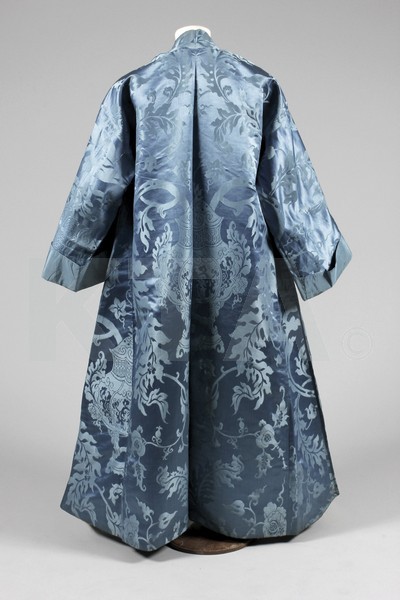 |
| A fitted banyan, 1750-60 |
Having the banyan quilted throughout was a common design.
 |
| 1740 |
It was common for a banyan to be made of a very colourful fabric; the banyan was a product of the Eastern-influence - it compares to a kimono - which was quite in fashion at the time. As it happens the word "banyan" is an anglicised version of the Gujerati (Indian) word for "trader".
Actually, they became so popular that it was acceptable for men in the latter part of the 18th century to be painted wearing a banyan instead of the more formal court suits. The banyan had a dominating collar as well as long sleeves.
  |
| Back and front of a beautifully preserved banyan |
The gorgeous example above is French and was created between 1730-40 and is made of Chinese brocade silk - expensive stuff. Not all were of that expensive a material; some were of simpler wool.
It was not uncommon for a banyan to be sewn in such a way that it could be worn with either side out. Usually, the banyan would be sewn in Europe with fabrics imported from the Far East but some were sewn before shipping. The banyan could be fashioned in several ways. One is depicted in the blue banyan above where it simply hangs in a kimono-like style while another was tied with ribbons or fastened with buttons. Some were double-lined for warmth while others were intended for summer use and as such were lighter. The fabrics, too, varied according to season. In the cold winter climate silk, wool and velvet were preferred while a summer-banyan was more likely to be made of calico or a like fabric.
 |
| Here worn over waistcoat and breeches, 1720, France |
The kimono-typed banyan usually reached the floor while those that were more fitted only reached about knee-length. One of the most convenient aspects of a banyan were the pockets. Rather than having pockets of its own it was usually cut in such a way that the wearer could reach directly into the pockets of his breeches - the space also allowed space for a sword hilt.
As worn in portraits:
 |
| Dr, Charles Chauncey |
 |
| Mozart by Duplessis |
 |
| Unknown gentleman |
 |
| Alexander Stewart |
 |
| Nicolas Boileau-Despréaux |

No comments:
Post a Comment